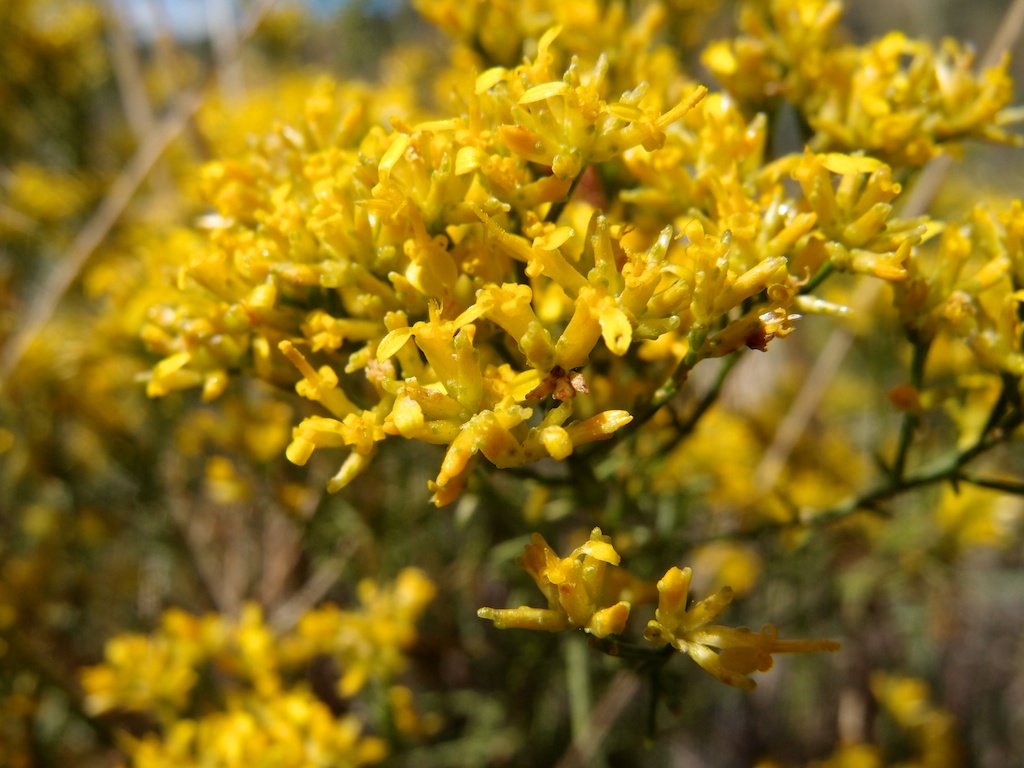
|
Family: Asteraceae |
Annuals, perennials, or subshrubs, 10-150(-200) cm (taprooted). Stems erect to ascending, usually branched, glabrous or papillate-scabrous to minutely hispidulous or scabro-hirtellous. Leaves basal (persistent or absent at flowering) and cauline; alternate; sessile or petiolate (decurrent); blades (1-5-nerved) linear to lanceolate or spatulate, margins entire (sometimes scabroso-ciliate), faces glabrous or minutely hairy, gland-dotted (sometimes obscurely), resinous. Heads radiate, borne singly or (3-6) in clusters or glomerules. Involucres cylindric to campanulate, (2-11.5 ×) 0.8-7.5 mm. Phyllaries 4-40 in 2-4 series (stramineous), 1- or 3-nerved, (sometimes strongly convex or keeled), ovate to lanceolate, unequal, bases white-indurate, margins narrowly scarious, abaxial faces glabrous or sparsely hispidulous or hirtellous. Receptacles flat to conic, pitted (hairy, hairs 1-seriate, swollen, apically hooked), epaleate. Ray florets 1-30, pistillate, fertile; corollas yellow or white (laminae coiling). Disc florets 1-150, bisexual, fertile, sometimes functionally staminate; corollas yellow or white, tubes shorter than funnelform throats, lobes 5, erect, short-deltate; style-branch appendages linear-lanceolate. Cypselae (light tan to purplish black) clavate or cylindric, not compressed, 5-8-nerved, hairy (glabrous in G. wrightii; hairs white, usually arising primarily from between ribs, appearing to occur in longitudinal lines, usually obscuring faces, apices acute or blunt with terminal cells slightly divergent, or clavate to bulbous); pappi persistent or readily falling, coroniform or of 5-10 whitish, irregular, sometimes ± connate, often erose-margined, scales in 1-2 series (usually longer in discs than rays). x = 4. Amphiachyris sometimes has been placed within Gutierrezia; it was treated as distinct by M. A. Lane (1982). The monotypic genus Thurovia from southeast Texas was included in Gutierrezia by Lane; recent molecular data support its status as a separate genus. Evidence from Y. Suh and B. B. Simpson (1990) suggested that Amphiachyris and Thurovia form the sister group to Gutierrezia. The taxonomic history of Gutierrezia also has been intertwined with species of Xanthocephalum, a genus superficially similar to Gutierrezia but more closely related to Grindelia and Isocoma. Gutierrezia is recognized by its taprooted habit, gland-dotted leaves, small heads, receptacles with fimbriate pit borders, funnelform disc corollas, clavate-hairy cypselae, pappi coroniform or of scales, and base chromosome number of x = 4. Polyploidy is common but of little taxonomic significance; polyploids of different levels tend to be scattered through the range of a species, and populations often comprise mixtures of individuals of different euploid levels (M. A. Lane 1985).
Heads radiate, the rays pistillate and fertile, often few; invol bracts strongly imbricate, glutinous, herbaceous-tipped; receptacle flat to conic or hemispheric, alveolate and evidently pubescent; disk-fls perfect and fertile; style-branches flattened, with long, slender, externally short-hairy appendage; achenes ±clavate, pubescent, usually several-nerved; pappus of the disk-fls of 1-2 series of white, erose scales evidently shorter than the cor, often united at base (rarely none), that of the rays ±reduced or even obsolete; taprooted herbs or shrubs, generally glabrous and often glutinous, with alternate, narrow, entire, commonly punctate lvs and usually numerous small yellow heads in a terminal, often flat-topped infl. 15, N. Amer. Gleason, Henry A. & Cronquist, Arthur J. 1991. Manual of vascular plants of northeastern United States and adjacent Canada. lxxv + 910 pp. ©The New York Botanical Garden. All rights reserved. Used by permission. |
This project was made possible in part by the Institute of Museum and Library Services [MG-70-19-0057-19].
Powered by Symbiota



